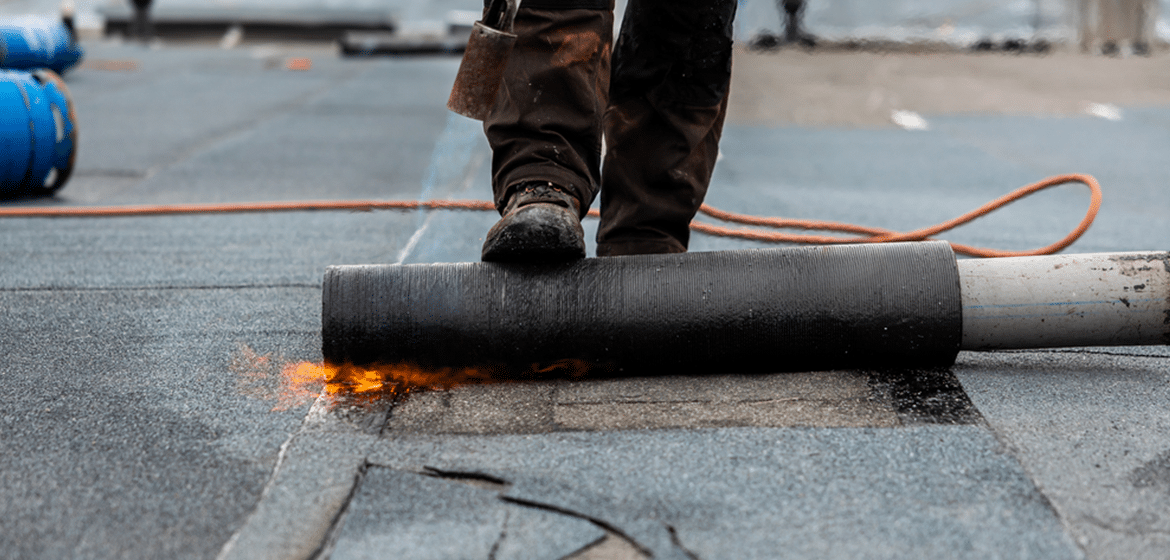
A built-up roof (BUR) is one of the most common and reliable roofing systems used for flat or low-slope roofs. Known for its durability and robustness, a built-up roof has been a preferred choice for commercial buildings for over a century. But what exactly is a built-up roof, and why has it remained so popular?
Understanding Built-Up Roofing
Built-up roofing (BUR) is a traditional roofing system designed for flat or low-slope roofs. It consists of multiple layers of bitumen (asphalt or coal tar) and reinforcing fabrics, creating a durable and waterproof membrane. The construction involves alternating layers of hot or cold bitumen with reinforcing fabrics, topped with a surfacing material like gravel or mineral granules for UV protection and weather resistance.
Advantages of BUR include excellent durability, longevity (lasting 20-30 years or more), fire resistance, and low maintenance requirements. However, it also has disadvantages such as labor-intensive installation, significant weight that may require extra structural support, strong odors during application, and higher initial costs.
Commonly used in commercial buildings, schools, and hospitals, BUR is valued for its robust protection against the elements. Regular inspections and maintenance are crucial to address any issues and extend the roof’s lifespan.
The Composition of Built-Up Roofing
Built-up roofing systems are typically composed of three main components:
- Base Sheets: These are the initial layers that are adhered to the roof deck. The base sheet provides a solid foundation for the other layers and helps with insulation.
- Ply Sheets: These reinforcing layers are usually made of fiberglass or polyester. They are saturated with bitumen and provide strength and durability to the roofing system.
- Surfacing: The top layer of a built-up roof is often finished with an aggregate, such as gravel or slag, or a reflective coating. This layer protects the underlying bitumen and ply sheets from UV radiation, weathering, and mechanical damage.
Types of Bitumen Used
There are primarily two types of bitumen used in built-up roofing systems:
- Asphalt: This is the most common type of bitumen used. Asphalt is affordable, easy to apply, and provides excellent waterproofing properties.
- Coal Tar: Coal tar is more resistant to chemicals and has better waterproofing properties compared to asphalt. However, it is more expensive and can be hazardous to work with due to its toxic fumes.
Installation Process
The installation of a built-up roof involves several steps, each critical to ensure the longevity and performance of the roofing system.
- Preparing the Roof Deck
The first step is to prepare the roof deck. This involves cleaning the surface to remove any debris, dust, or old roofing material. A clean and smooth surface ensures proper adhesion of the base sheet.
- Applying the Base Sheet
Once the roof deck is prepared, the base sheet is applied. This sheet can be mechanically fastened or adhered to using a hot asphalt or cold adhesive. The base sheet acts as the foundation for the subsequent layers.
- Installing Ply Sheets
After the base sheet is in place, the ply sheets are applied. Each ply sheet is embedded in a layer of hot asphalt or cold adhesive. The number of ply sheets used can vary, but typically, a built-up roof will have three to five ply sheets. These sheets are installed in overlapping layers to ensure maximum strength and waterproofing.
- Adding the Surfacing Layer
The final step is to apply the surfacing layer. This can be done by embedding gravel or applying a reflective coating. The surfacing layer protects the underlying bitumen and ply sheets from UV radiation, weathering, and mechanical damage.
Advantages of Built-Up Roofing
Built-up roofing systems offer several advantages, making them a popular choice for commercial buildings.
- Durability
One of the main benefits of built-up roofing is its durability. The multiple layers of bitumen and reinforcing fabrics create a robust roofing system that can withstand various environmental stresses, including heavy rain, wind, and temperature fluctuations.
- Waterproofing
Built-up roofing systems provide excellent waterproofing. The multiple layers of bitumen and ply sheets create a watertight barrier that prevents water from penetrating the roof. This is especially important for flat or low-slope roofs, where water can easily accumulate.
- UV Protection
The surfacing layer of a built-up roof protects against UV radiation. This helps to extend the lifespan of the roofing system and prevent premature aging.
- Low Maintenance
Built-up roofs are relatively low maintenance. Regular roof inspections and minor repairs can help extend the lifespan of the roofing system and prevent major issues from developing.
- Fire Resistance
Built-up roofing systems are also known for their fire resistance. The layers of bitumen and ply sheets create a fire-resistant barrier that can help to slow down the spread of fire.
Disadvantages of Built-Up Roofing
While built-up roofing systems offer many advantages, there are also some drawbacks to consider.
- Installation Time
The installation of a built-up roof can be time-consuming. The process involves multiple steps, and each layer must be properly applied to ensure the longevity and performance of the roofing system.
- Weight
Built-up roofs can be heavy due to the multiple layers of bitumen and reinforcing fabrics. This can put additional stress on the building structure and may require additional support.
- Cost
The cost of a built-up roof can be higher compared to other roofing systems. The materials and labor required for installation can add up, making it a more expensive option.
Built-Up Roof Maintenance and Inspection
Maintaining a built-up roof is essential for ensuring its longevity and performance. Regular maintenance and inspections can help identify and address potential issues before they become major problems. Here are some key maintenance and inspection practices for built-up roofs.
Regular Inspections
Regular roof inspections are crucial for identifying potential issues early. It’s recommended to have a professional roof inspection at least twice a year, typically in the spring and fall. Inspections should also be conducted after major weather events, such as storms or heavy rainfall, to assess any damage.
During an inspection, a roofing professional will look for signs of wear and tear, such as:
- Blisters: Raised areas on the roof surface caused by trapped air or moisture.
- Cracks and Splits: Cracks in the bitumen or ply sheets can compromise the roof’s waterproofing capabilities.
- Ponding Water: Areas where water accumulates and doesn’t drain properly can lead to leaks and structural damage.
- Loose or Missing Gravel: The surfacing layer of gravel should be evenly distributed. Areas with loose or missing gravel need to be addressed to protect the underlying layers.
Cleaning the Roof Surface
Keeping the roof surface clean is another important aspect of maintenance. Debris, such as leaves, branches, and dirt, can accumulate on the roof and clog drainage systems, leading to water buildup and potential damage. Regularly cleaning the roof surface helps ensure proper drainage and prevents issues caused by standing water.
Addressing Minor Repairs
Minor repairs should be addressed promptly to prevent them from becoming major issues. Small cracks or blisters can be repaired with roofing cement or bitumen patches. It’s important to use compatible materials to ensure a proper seal and maintain the integrity of the roofing system.
Comparing Built-Up Roofing to Other Roofing Systems
While built-up roofing offers numerous benefits, it’s also helpful to compare it to other roofing systems to determine the best option for your building. Here are some comparisons between built-up roofing and other common roofing systems.
- Built-Up Roofing vs. Modified Bitumen Roofing
Modified bitumen roofing is another popular choice for flat or low-slope roofs. This system consists of layers of bitumen modified with polymers for enhanced durability and flexibility.
While both built-up and modified bitumen roofs offer excellent waterproofing and durability, modified bitumen roofs are typically easier and quicker to install.
However, built-up roofs tend to have a longer lifespan and better resistance to foot traffic and mechanical damage.
- Built-Up Roofing vs. Single-Ply Roofing
Single-ply roofing systems, such as TPO (Thermoplastic Olefin) and EPDM (Ethylene Propylene Diene Monomer), consist of a single layer of membrane applied to the roof deck. These systems are known for their ease of installation, flexibility, and energy efficiency.
While single-ply roofs are lighter and can be installed more quickly than built-up roofs, they may not provide the same level of durability and impact resistance. Built-up roofs, with their multiple layers, offer superior protection against punctures and mechanical damage.
Innovations in Built-Up Roofing
The roofing industry continues to innovate, and built-up roofing systems are no exception. Recent advancements have focused on improving the environmental performance, durability, and ease of installation of built-up roofs.
- Cool Roof Technologies
Cool roof technologies involve using reflective coatings and materials to reduce the roof’s heat absorption. These technologies are increasingly being integrated into built-up roofing systems to improve energy efficiency and reduce cooling costs.
- Sustainable Materials
Manufacturers are developing more sustainable materials for built-up roofing systems. For example, some companies are producing bitumen from recycled materials or using bio-based alternatives to traditional petroleum-based bitumen. These innovations aim to reduce the environmental impact of built-up roofs.
- Enhanced Installation Techniques
New installation techniques are being developed to improve the efficiency and safety of installing built-up roofs. For example, cold-applied adhesives are being used as an alternative to hot asphalt, reducing the health and safety risks associated with hot-applied bitumen.
Choosing the Right Roofing Contractor
Selecting a qualified roofing contractor is essential for the successful installation and maintenance of a built-up roof. Here are some tips for choosing the right contractor:
- Experience and Expertise
Look for a contractor with extensive experience and expertise in installing and maintaining built-up roofing systems. Ask for references and check their track record of completed projects.
- Certifications and Insurance
Ensure the contractor is properly certified and insured. Certifications from reputable roofing organizations indicate that the contractor has met industry standards for quality and safety. Insurance protects you from liability in case of accidents or damage during the project.
- Detailed Proposal
A professional roofing contractor should provide a detailed proposal outlining the scope of work, materials to be used, and a timeline for the project. This helps ensure transparency and sets clear expectations for both parties.
- Warranty
Check if the contractor offers a warranty on their workmanship and the roofing materials. A warranty provides peace of mind and protection in case of any issues with the roof after installation.
Ensuring Durable and Reliable Roofing
Built-up roofing remains a reliable and durable choice for flat and low-slope roofs. With its multiple layers of bitumen and reinforcing fabrics, built-up roofing provides excellent waterproofing, durability, and UV protection.
Regular maintenance and inspections are crucial for ensuring the longevity and performance of built-up roofs. By understanding the advantages, disadvantages, and innovations in built-up roofing, building owners can make informed decisions about their roofing systems.
For professional roofing services, including built-up roof installation and maintenance, contact us at Dane Roofing. We pride ourselves on our expertise and commitment to customer satisfaction. Let us help you with all your roofing needs, ensuring the highest level of quality and service.
Call us today or visit our website to schedule a consultation.

